 For travelling PocketPC users unsure whether to pack away a brolly or load up with the sunscreen lotion, Spb Weather could prove to be an essential tool.
For travelling PocketPC users unsure whether to pack away a brolly or load up with the sunscreen lotion, Spb Weather could prove to be an essential tool.
The weather forecast plug-in for the ‘Today’ screen on PocketPC serves up a veritable storm of weather-related information in a neat, concise interface.
Spb Weather is designed to display the latest worldwide weather reports from a variety of weather sources including GisMeteo, Intellicast, and Weather.com, with the option for users to specify their own data source.
Installation on to a Pocket PC was straightforward enough using Microsoft Activesync, with no faffing about with firewalls needed for the app to automatically update the forecasts from the web (you can specify when and how often you want updates to occur).
I decided to install it on to the storage card of my XDA Compact (iMate JAM) and it ran with no problems.
 Once installed, it’s simply a case of choosing the cities you want displayed (you can manually add unlisted locations), and then having a fiddle about with all the fun display options lurking in the options dialog.
Once installed, it’s simply a case of choosing the cities you want displayed (you can manually add unlisted locations), and then having a fiddle about with all the fun display options lurking in the options dialog.
You can rummage through a wide variety of nicely-designed skins, icons and layouts, and decide how you want the information to be presented on your ‘Today’ screen, with options to select a 4 day, 5 day, 7 day or multiline view.
Clicking on a specific day brings up a detailed forecast for the day, with a mass of facts about temperature, humidity, pressure and wind information.
I’ve set the program to show me the weather in various cities around the world – including my home town and locations I’ll be travelling to shortly – and, of course, my lovely Cardiff, where the ‘rain’ icon seems to appear with alarming regularity.
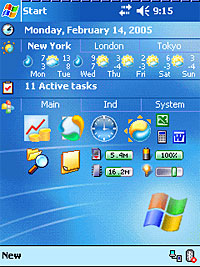 For travellers, tourists and stay-at-homers with a passing interest in the weather, this is a handy, fun application that adds real value to a Pocket PC. Recommended.
For travellers, tourists and stay-at-homers with a passing interest in the weather, this is a handy, fun application that adds real value to a Pocket PC. Recommended.
Star rating: 5/5 ![]()
![]()
Cost: US$14.95 (~£8.50~€12.30)
Tech requirements: 2.0 MB space on handheld, Pocket PC 2002 or Windows Mobile 2003 device
 Mobile download site Handango has announced the winners of their Champion Awards at the fifth annual Handango Partner Summit.
Mobile download site Handango has announced the winners of their Champion Awards at the fifth annual Handango Partner Summit. 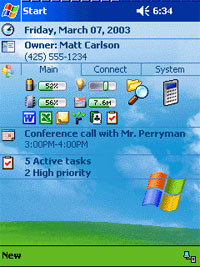 For the Palm platform, the winners included Snapper Mail Deluxe in the ‘work application’ category, with Pocket Tunes Deluxe scooping up the ‘Play’ category.
For the Palm platform, the winners included Snapper Mail Deluxe in the ‘work application’ category, with Pocket Tunes Deluxe scooping up the ‘Play’ category. 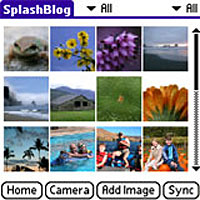 The comprehensive MobiLearn Talking Phrasebook, a talking multi-language phrasebook for the Pocket PC with “pure native voices”, snagged the “Best Industry Application” award.
The comprehensive MobiLearn Talking Phrasebook, a talking multi-language phrasebook for the Pocket PC with “pure native voices”, snagged the “Best Industry Application” award.  These days, a smartphone/PDA isn’t worth sniffing at unless it comes with a built in camera and a shedload of internal/external memory for storing mobile snaps on.
These days, a smartphone/PDA isn’t worth sniffing at unless it comes with a built in camera and a shedload of internal/external memory for storing mobile snaps on.  When you install the Pocket PC program, there’s also an option to install the Resco Album Generator on your desktop PC – this program lets you create photo albums ON your desktop and then have the pictures and the album information transferred to your handheld device on the next sync.
When you install the Pocket PC program, there’s also an option to install the Resco Album Generator on your desktop PC – this program lets you create photo albums ON your desktop and then have the pictures and the album information transferred to your handheld device on the next sync. 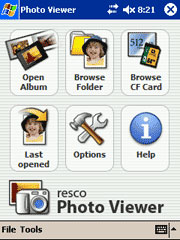 In full screen mode, the keypad can be used to scroll through picture collections manually, or users with tired fingers can set up a slide show and choose from a selection of transition fades and effects.
In full screen mode, the keypad can be used to scroll through picture collections manually, or users with tired fingers can set up a slide show and choose from a selection of transition fades and effects. 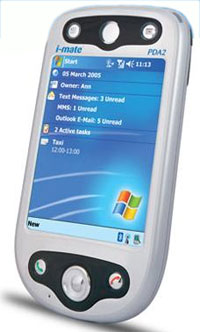 Dubai-based Microsoft Windows mobile specialists i-mate have added the HTC-manufactured i-mate PDA2 to their popular range of Pocket PC phones.
Dubai-based Microsoft Windows mobile specialists i-mate have added the HTC-manufactured i-mate PDA2 to their popular range of Pocket PC phones. 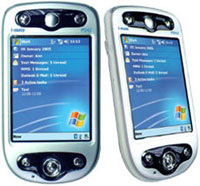 Memory can be expanded through a SD/MMC slot, also compatible with SDIO peripherals.
Memory can be expanded through a SD/MMC slot, also compatible with SDIO peripherals. 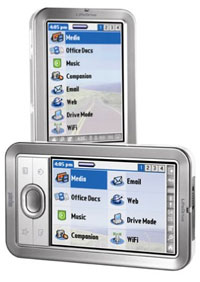 After months of rumours on the Web, details of palmOne’s new LifeDrive PDA have finally shown up on Amazon.
After months of rumours on the Web, details of palmOne’s new LifeDrive PDA have finally shown up on Amazon. 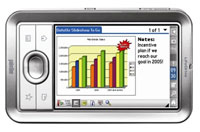 NormSoft’s Pocket Tunes is able to play MP3, WMA, Ogg Vorbis, and WAV files and the unit will also support full screen video and photo playback.
NormSoft’s Pocket Tunes is able to play MP3, WMA, Ogg Vorbis, and WAV files and the unit will also support full screen video and photo playback. 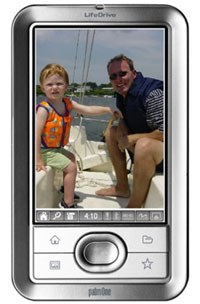 The LifeDrive comes with USB 2.0, so transferring files onto the microdrive should be a fairly nifty business.
The LifeDrive comes with USB 2.0, so transferring files onto the microdrive should be a fairly nifty business. 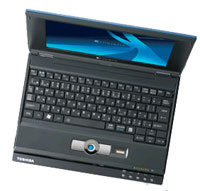 As part of Toshiba’s 20th anniversary celebration of the first laptop computer, the company has brought back its libretto line of ultraportables, starting with the miniscule U100.
As part of Toshiba’s 20th anniversary celebration of the first laptop computer, the company has brought back its libretto line of ultraportables, starting with the miniscule U100. 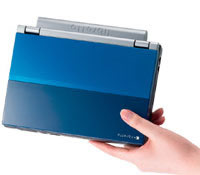 For maximum security, the pint-sized palmtop wedges in a biometric, integrated fingerprint reader with the 60 GB hard drive being protected by Toshiba’s ‘EasyGuard’ technology.
For maximum security, the pint-sized palmtop wedges in a biometric, integrated fingerprint reader with the 60 GB hard drive being protected by Toshiba’s ‘EasyGuard’ technology.  Measuring in at a humble 8.3 x 6.5 x 1.2 inches, the libretto U100 retails for US$1,999 (£1,045/€1,500) in the US, with a possibility of a European release this summer.
Measuring in at a humble 8.3 x 6.5 x 1.2 inches, the libretto U100 retails for US$1,999 (£1,045/€1,500) in the US, with a possibility of a European release this summer.  PalmOne’s Tungsten E – introduced in 2004 – proved to be a rip-roaring success, becoming the top-selling handheld in North America and among one of the best sellers world-wide.
PalmOne’s Tungsten E – introduced in 2004 – proved to be a rip-roaring success, becoming the top-selling handheld in North America and among one of the best sellers world-wide.  Apart from the inclusion of palmOne’s new Multi-Connector serial port (replacing the previous mini-USB port), everything is much the same as its predecessor, with the directional pad, application buttons, SDIO slot, IR port, headphone jack and metal barrel stylus being unchanged.
Apart from the inclusion of palmOne’s new Multi-Connector serial port (replacing the previous mini-USB port), everything is much the same as its predecessor, with the directional pad, application buttons, SDIO slot, IR port, headphone jack and metal barrel stylus being unchanged. 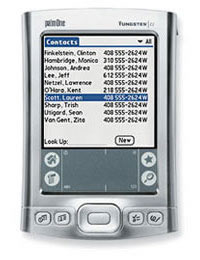 Other software includes a media suite (for playing back videos or viewing photo stills) an upgraded PIM suite, Web browser in ROM, with VersaMail and Documents To Go available on the included CD.
Other software includes a media suite (for playing back videos or viewing photo stills) an upgraded PIM suite, Web browser in ROM, with VersaMail and Documents To Go available on the included CD.  It’s been delayed more times than the 8:25 from East Grinstead on a leaf-strewn morning, but Fossil has finally released its super geeky Fossil Wrist PDA Palm Powered watch.
It’s been delayed more times than the 8:25 from East Grinstead on a leaf-strewn morning, but Fossil has finally released its super geeky Fossil Wrist PDA Palm Powered watch. 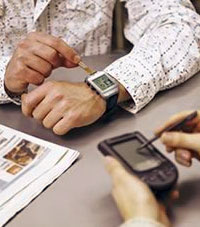 The watch itself is made of stainless steel, with a teensy weensy fold out stylus cunningly secreted in the strap buckle. Fossil have managed to fit in a USB socket and infra red port, along with three buttons and a rocker switch for onscreen navigation.
The watch itself is made of stainless steel, with a teensy weensy fold out stylus cunningly secreted in the strap buckle. Fossil have managed to fit in a USB socket and infra red port, along with three buttons and a rocker switch for onscreen navigation.  Frontier Silicon, the British company that makes chips for mobile digital television and digital radio products, has completed it US$28 million (€21m/£14.5m) investment round funding.
Frontier Silicon, the British company that makes chips for mobile digital television and digital radio products, has completed it US$28 million (€21m/£14.5m) investment round funding.  “This latest investment allows us to aggressively target and drive market share in the emerging mobile digital television market in the same way that we have established our chips in over 70 percent of DAB digital radios,” said Anthony Sethill.
“This latest investment allows us to aggressively target and drive market share in the emerging mobile digital television market in the same way that we have established our chips in over 70 percent of DAB digital radios,” said Anthony Sethill.  Sony has announced that it is to end production on its Clie line of PDAs in Japan.
Sony has announced that it is to end production on its Clie line of PDAs in Japan.  Our guess is that they’re going to focus their energies on ramping up the feature list on Sony Ericsson smartphones, developing the PlayStation Portable and finally producing the iPod killer they so desperately need.
Our guess is that they’re going to focus their energies on ramping up the feature list on Sony Ericsson smartphones, developing the PlayStation Portable and finally producing the iPod killer they so desperately need.